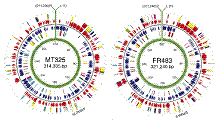Virology, Nebraska Center for
Date of this Version
2023
Citation
Dunigan, D.D.; Agarkova, I.V.; Esmael, A.; Alvarez, S.; Van Etten, J.L. Early-Phase Drive to the Precursor Pool: Chloroviruses Dive into the Deep End of Nucleotide Metabolism. Viruses 2023, 15, 911. https://doi.org/10.3390/v15040911
Abstract
Viruses face many challenges on their road to successful replication, and they meet those challenges by reprogramming the intracellular environment. Two major issues challenging Paramecium bursaria chlorella virus 1 (PBCV-1, genus Chlorovirus, family Phycodnaviridae) at the level of DNA replication are (i) the host cell has a DNA G+C content of 66%, while the virus is 40%; and (ii) the initial quantity of DNA in the haploid host cell is approximately 50 fg, yet the virus will make approximately 350 fg of DNA within hours of infection to produce approximately 1000 virions per cell. Thus, the quality and quantity of DNA (and RNA) would seem to restrict replication efficiency, with the looming problem of viral DNA synthesis beginning in only 60–90 min. Our analysis includes (i) genomics and functional annotation to determine gene augmentation and complementation of the nucleotide biosynthesis pathway by the virus, (ii) transcriptional profiling of these genes, and (iii) metabolomics of nucleotide intermediates. The studies indicate that PBCV-1 reprograms the pyrimidine biosynthesis pathway to rebalance the intracellular nucleotide pools both qualitatively and quantitatively, prior to viral DNA amplification, and reflects the genomes of the progeny virus, providing a successful road to virus infection.
Included in
Biological Phenomena, Cell Phenomena, and Immunity Commons, Cell and Developmental Biology Commons, Genetics and Genomics Commons, Infectious Disease Commons, Medical Immunology Commons, Medical Pathology Commons, Virology Commons


Comments
Copyright: © 2023 by the authors. Licensee MDPI, Basel, Switzerland. This article is an open access article distributed under the terms and conditions of the Creative Commons Attribution (CC BY) license